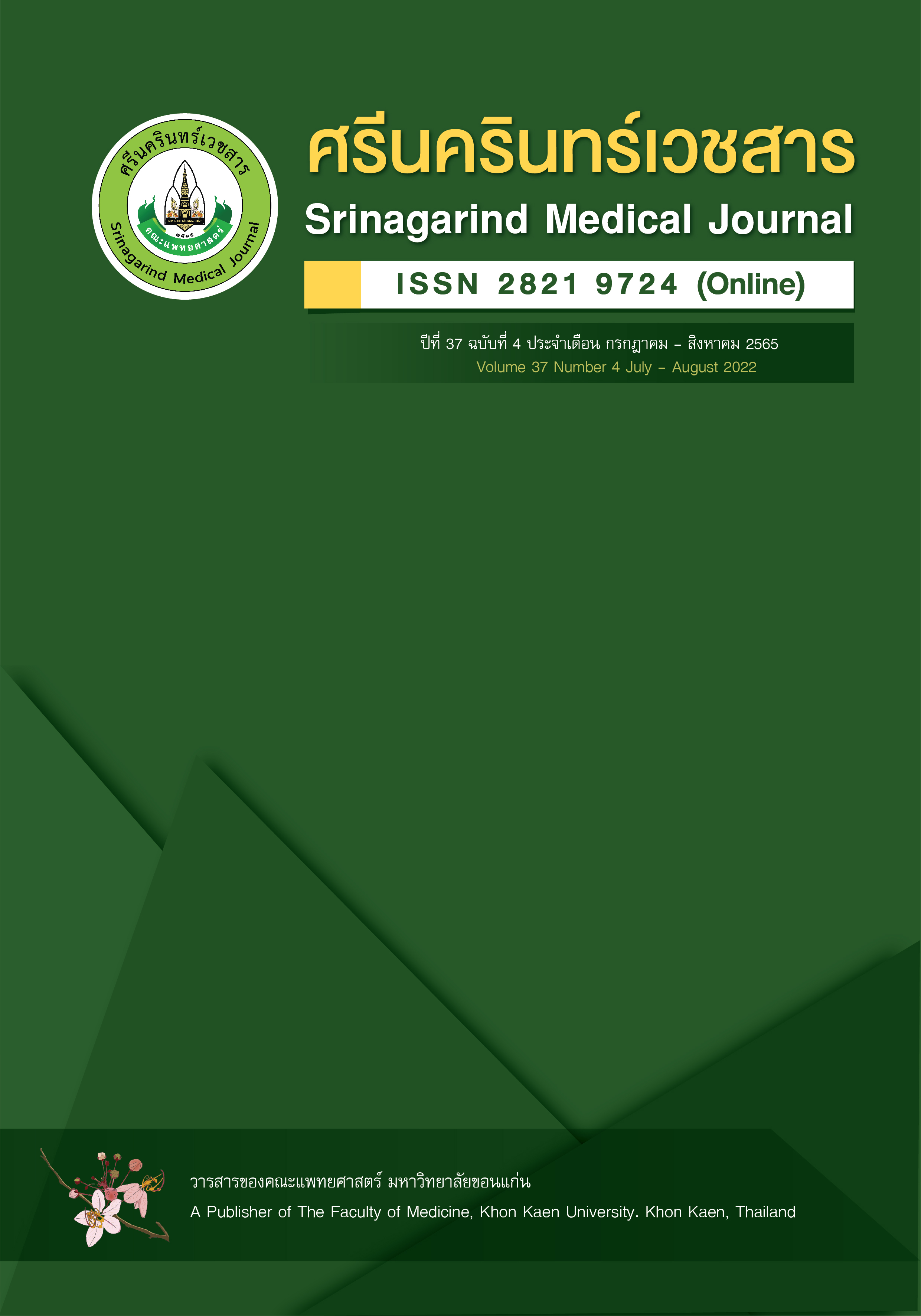ผลของระยะเวลาการได้รับยาเพรดนิโซโลนขนาดต่ำ ต่อการสูญเสียการตอบสนองในการรักษาผู้ป่วยโรคเกล็ดเลือดต่ำจากภูมิคุ้มกัน
Effect of Low-Dose Prednisolone Durations on Loss of Response Rates in Patients with Immune Thrombocytopenia
Abstract
ผลของระยะเวลาการได้รับยาเพรดนิโซโลนขนาดต่ำ ต่อการสูญเสียการตอบสนองในการรักษาผู้ป่วยโรคเกล็ดเลือดต่ำจากภูมิคุ้มกัน
ทนงศักดิ์ สุวรรณเทน*, ฟารีดา พลีบัตร
กลุ่มงานอายุรกรรม โรงพยาบาลขอนแก่น
Effect of Low-Dose Prednisolone Durations on Loss of Response Rates in Patients with Immune Thrombocytopenia
Thanongsak Suwannathen*, Fareeda Pleebut
Department of Medicine, Khon Kaen Hospital.
หลักการและวัตถุประสงค์: สเตียรอยด์เป็นยาชนิดแรกที่ใช้ในการรักษาผู้ป่วยโรคเกล็ดเลือดต่ำจากภูมิคุ้มกัน (immune thrombocytopenia, ITP) ข้อมูลปัจจุบันพบว่าให้ผลการรักษาดี แต่หลังหยุดยาผู้ป่วยประมาณ 2 ใน 3 โรคกลับเป็นซ้ำหรือมีระดับเกล็ดเลือดลดต่ำลงมาก การศึกษาครั้งนี้จึงมีวัตถุประสงค์เพื่อศึกษาความสัมพันธ์ระหว่าง ระยะเวลาในการรักษาโรค ITP ด้วยยาเพรดนิโซโลนขนาดต่ำ (ไม่เกิน 10 มิลลิกรัมต่อวัน) ต่ออัตราการสูญเสียการตอบสนองในการรักษา (loss of response) หรือการกลับเป็นซ้ำของโรค (relapse) ของผู้ป่วย
วิธีการศึกษา: ศึกษาข้อมูลย้อนหลังจากเวชระเบียนของผู้ป่วย ที่ได้รับการวินิจฉัยโรค ITP และรับการรักษาที่โรงพยาบาลขอนแก่น ตั้งแต่วันที่ 31 ตุลาคม 2554 ถึง 1 พฤศจิกายน 2563 วิเคราะห์ระยะปลอดเหตุการณ์โดยใช้โค้งของ Kaplan และ Meier หาความสัมพันธ์ของปัจจัยโดยใช้โมเดลการถดถอยของ Cox และใช้สถิติ log-rank test ในการเปรียบเทียบระหว่างกลุ่ม
ผลการศึกษา: ผู้ป่วย ITP ทั้งหมด 118 ราย, เป็นเพศหญิง ร้อยละ 78, เป็นผู้ป่วยโรค ITP ที่ได้รับการวินิจฉัยครั้งแรก ร้อยละ 82.2, อายุเฉลี่ย 47.4 ± 17.5 ปี, ผู้ป่วยร้อยละ 78.8 ตอบสนองต่อการรักษาอย่างสมบูรณ์, พบว่าหลังจากลดขนาดยาเพรดนิโซโลนเป็นขนาดต่ำ ครึ่งหนึ่งของผู้ป่วยในกลุ่มที่ได้รับการรักษาด้วยยาเพรดนิโซโลนขนาดต่ำระยะเวลาไม่เกิน 6 เดือน เปรียบเทียบกับกลุ่มที่ระยะเวลานานกว่า 6 เดือน จะเกิดการกลับเป็นซ้ำหรือสูญเสียการตอบสนองในการรักษา (median event-free survival) ที่ระยะเวลา 7.2 เดือน (95%CI, 5.0 – 22.8) และ 34.4 เดือน (95%CI, 17.8 – 79.5) ตามลำดับ โดยมีค่า hazard ratio เท่ากับ 2.24 (95%CI, 1.39 – 3.65, p-value = 0.001) สำหรับภาวะแทรกซ้อนจากยาสเตียรอยด์ที่พบในงานวิจัย ไม่มีความแตกต่างอย่างมีนัยสำคัญระหว่างผู้ป่วยทั้งสองกลุ่ม
สรุป: ผู้ป่วยโรคเกล็ดเลือดต่ำจากภูมิคุ้มกันที่ได้รับการรักษาด้วยยาเพรดนิโซโลนขนาดต่ำ ระยะเวลาไม่เกิน 6 เดือน เพิ่มอัตราการสูญเสียการตอบสนองในการรักษาหรือเกิดการกลับเป็นซ้ำของโรคอย่างมีนัยสำคัญ
คำสำคัญ: ยาเพรดนิโซโลนขนาดต่ำ, กลับเป็นซ้ำ, สูญเสียการตอบสนอง, โรคเกล็ดเลือดต่ำจากภูมิคุ้มกัน
Background and Objective: Currently, the standard first-line treatment for patients with immune thrombocytopenia (ITP) patients is corticosteroids. Although most patients are responses to treatment, two-thirds of patients relapse or loss of response after discontinuing medication. The objective of this study was to evaluate the association between low-dose prednisolone durations (≤10 mg/day) and event (loss of response or relapse) rates in ITP patients.
Methods: The retrospective cohort study collected data from medical records of patients diagnosed ITP, treated at Khon Kaen Hospital from October 31st, 2011 to November 1st, 2020. The data were analyzed using Kaplan-Meier curve to analyze survival, Cox regression and log-rank test to compare between groups.
Results: One hundred and eighteen ITP patients were included, 78% were female, 82% were newly diagnosed ITP, mean age was 47.4 ± 17.5 years, 78.8% reached complete response after initial treatment. Median event-free survival after started low-dose prednisolone (LDP) in patients received LDP duration ≤6 months compare with LDP duration >6 months was 7.2 months (95%CI, 5.0 – 22.8) and 34.4 months (95%CI, 17.8 – 79.5), respectively, with hazard ratio 2.24 (95%CI, 1.39 – 3.65). Adverse effects from corticosteroids therapy in this study were not statistically significant differences between the two groups of patients.
Conclusions: Low-dose prednisolone treatment duration no more than 6 months was associated with higher rates of relapse or loss of response in ITP patients.
Keyword: Low-dose prednisolone, Relapse, Loss of response, Immune thrombocytopenia


